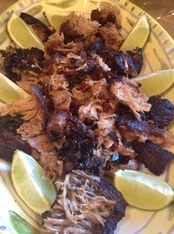 oven and let it roast until it’s ready to serve. The roast can, of course, be grilled, but some cooks believe that oven roasting yields a crispier skin.
oven and let it roast until it’s ready to serve. The roast can, of course, be grilled, but some cooks believe that oven roasting yields a crispier skin. |
Selection
|
Approx. Price |
Comments |
|
Bisol, Valdobbiadene (Italy) Prosecco Superiore “Crede” 2014 (Imported by Vias Imports)
|
$23
|
A touch sweet, with ripe fruit flavors, this wine did not taste all that special on its own but shined brightly as a foil for the pork. It enlivened the dish and, to our considerable surprise, made for a fantastic match. |
|
Decoy, Sonoma County (California) Merlot 2014
|
$25 |
The soft tannins in this Merlot are what gave it appeal when paired with the melt in your mouth pork dish. It was a successful match as much because of texture as flavor.
|
|
Dry Creek Vineyard Sonoma County (California) Zinfandel “Heritage Vines” 2014
|
$21 |
Fruity and brambly, with a rustic edge, this berry-rich wine gave the Pernil added depth of flavor. It made for a match notable for similarities, as each element complimented the other. |
|
J. Lohr Paso Robles (California) Petite Sirah “Tower Road” 2013
|
$35 |
We worried that this wine might be too big and powerful for a pork dish, but slow-roasting gives Pernil such deep, satisfying flavors that it was not at all intimidated. Instead, the dish matched the wine in every respect—forceful flavors, heady aromas, rich texture, and both depth and length on the palate. Yum! |
|
Robert Mondavi Napa Valley California Cabernet Sauvignon 2013
|
$28 |
A sumptuous Napa Cabernet, this wine, much like the Petite Sirah, tasted rich and ripe, and gave added depth to the dish. The fruit flavors in the two wines are very different—this one sweeter, the other more brooding—but the effect proved much the same.
|
